Address any questions or comments regarding this newsletter to the individual authors listed after each article or to its editors, Nathan Johanning, 618-939-3434, njohann@illinois.edu or Bronwyn Aly 618-695-6060, baly@illinois.edu. The Illinois Fruit and Vegetable News is available on the web at: http://ipm.illinois.edu/ifvn/. To receive or be removed from email notification of new postings of this newsletter, contact Nathan Johanning or Bronwyn Aly at the phone numbers or email addresses above.
In This Issue:
Upcoming Programs (listings for beginning and established growers)
News & Announcements (SARE Field Day Resources Available)
Regional Reports (northern, east central, metro east, and southern Illinois)
Fruit and Vegetable Production and Pest Management (Modified Growing Degree Days, Insect Update, Transplanting Cucurbits, Hops Highlight: Variety Selection)
Upcoming Programs
Check the Illinois SARE calendar for a full list of programs and links for registration.
http://illinoissare.org/ and http://illinoissare.org/calendar.php
Also see the University of Illinois Extension Local Food Systems and Small Farms Team's website at:
http://web.extension.illinois.edu/smallfarm/ and the calendar of events at http://web.extension.illinois.edu/units/calendar.cfm?UnitID=629.
- 2017 Southern Illinois Summer Twilight Series. Join University of Illinois Extension as they team up with area farmers to provide four monthly evening meetings to highlight and demonstrate diverse farming enterprises across southern Illinois. Growers and extension educators will provide information on the following topics: u-pick lavender production, growing fruits and vegetables within city limits, fresh cut flower production, mushroom production, and utilizing farmers markets, roadside stands, and CSA's to market products. We will also explore the impacts and importance of buying local to our local farms as they help to support a stronger, more sustainable, regional economy. Meetings will begin at 6 p.m. at the following locations:
July 17 2017 |
Flower Ridge Farm, Herod, IL |
August 14, 2017 |
Flyway Family Farm, Makanda, IL |
- There is no cost for these programs but pre-registration is appreciated. Please register online at http://web.extension.illinois.edu/ghhpsw/ or by phone 618-382-2662.
For more information please contact: Bronwyn Aly – 618-382-2662, baly@illinois.edu or Nathan Johanning – 618-687-1727, njohann@illinois.edu
- Produce Safety Grower Training Course, Tuesday, August 1, 2017 8:00am to 5:00pm CST Rend Lake College – Applied Science Center, 468 N. Ken Gray Parkway, Ina, Illinois 62846
The PSA Grower Training Course is one way to satisfy the FSMA Produce Safety Rule requirement outlined in § 112.22(c) that requires 'At least one supervisor or responsible party for your farm must have successfully completed food safety training at least equivalent to that received under standardized curriculum recognized as adequate by the Food and Drug Administration.' To register and find more information visit: https://web.extension.illinois.edu/registration/?RegistrationID=16919 or contact Laurie George at (618) 242-0780. The deadline to register for this training opportunity is July 17, 2017 and space is limited. - Southern Illinois Fruit & Vegetable Field Day, Monday, August 7, 2017, 4 p.m. Jackson County Extension Office, 402 Ava Rd. Murphysboro, IL 62966. Field Day topics and field trials include cover crops, pepper variety trials, ornamental corn variety trial, small fruit production, spotted wing drosophila management, high tunnel production, wildlife management and more. Registration information coming soon. For more information contact Nathan Johanning at njohann@illinois.edu or 618-687-1727.
News & Announcements
SARE Farmer Field Day Resources Available
Field days are a great way to share innovative ideas in sustainable agriculture with fellow farmers and ranchers, but organizing an event can be time consuming, especially if you have limited experience. This farmer field day toolkit can take some of the pressure off—it provides tips and tools on key aspects of event planning. Sections include: Tips for a Successful Field Day, Suggested Timeline, Working with the Media, Creating Press Releases and PSAs, Capturing the Event with Video, Downloadable Tools and Templates.
Download it as a 16-page PDF. More info here: http://www.sare.org/Grants/Farmer-Field-Day-Toolkit
Regional Reports
From northern Illinois...I don't know if you heard, but areas of northernmost Illinois (Rockford and surrounding) received 6+ inches of rain in the space of a few hours on Wednesday (6/28) evening. Two confirmed small EF-1 tornadoes, but the wind, hail, and flash flooding probably caused just as many problems. Here is a picture of my dad's corn field/swimming hole north of Pecatonica:
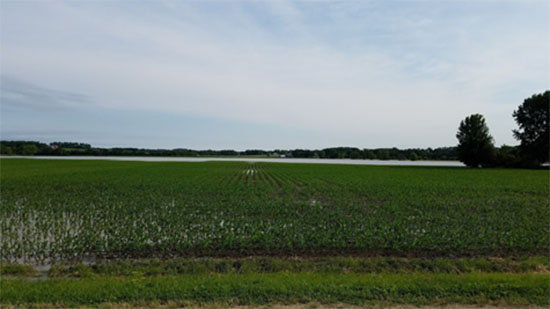
A car was floated off the road by 3 feet of rushing floodwater just north of here...woman called the fire department from her cell phone after climbing out onto the roof. We had raging rapids at the end of my driveway...almost took out my culvert. So did my dad on another creek less than a mile away. Floodwater had enough kinetic energy to carry away fence rows and large pieces of cement/asphalt at his place. I have observed blowouts of recently clipped waterways and trees broken off here and there. Obvious soil movement from unprotected areas...like my recently-planted sweet corn patch
I was up much off the night messing with generators and extension cords to power fans in the coop and fridges in the house. We got power back around lunchtime Thursday, but there are still folks without power as of Friday, according to ComEd's outage map: https://outagemap.comed.com/
Andy Larson (815-732-2191; andylars@illinois.edu)
From east central Illinois... Vegetables crops are looking good with few disease issues due to the dry weather, but Japanese Beetles, Plant bugs and various caterpillars are making up for the lack of disease pressure. Some issues with powdery mildew where overhead irrigation is being used. Local tomatoes and sweet corn are coming out of the fields in time for the July 4th Holiday and markets about a week earlier than most years.
The heavy rains of April 2017 have led to increased number of local raspberry growers suffering a rapid decline in cane health and plant death. Analysis has shown this to be due to Phytophthora Root Rot. In every instance, the raspberries were planted in heavy soils and poorly drained areas without making any allowance for better drainage, such as raised beds.
Doug Gucker (217-877-6042; dgucker@illinois.edu)
From the St. Louis Metro East...Sweet corn and peaches were in harvest for the Fourth of July target date. Peaches in the Redhaven window including cultivars like Bellaire, Blazing Star and PF Lucky 13 are in markets now, putting the season a little over a week ahead of the average. Blackberry harvest is ongoing, with Natchez finishing up, followed by Osage and Quachita. Apache is in the early stage of harvest. Aside from spotted wing drosophila, some sunburn and stinkbug injury are being reported.
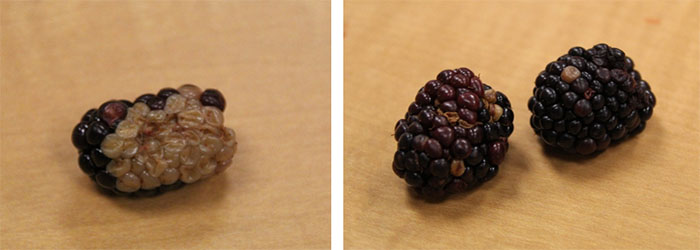
Sunburn on Blackberry (left) and Stink Bug Injury on Blackberry (right). All Photos E. Wahle
Though not considered a usual pest in the Midwest, grape scale is further making its presence known this growing season as infested trunks and cordons are beginning to collapse as summer conditions further stress vines. Donn Johnson, University of Arkansas has written a very good piece on management of grape scale. The article in its entirety may be found at http://comp.uark.edu/~dtjohnso/Grape_Scale_Dist_ID_Biol_PM_article_Feb_11.pdf

Exposed Grape Scale beneath peeling bark (left) and Collapsed cordon due to Grape Scale infestation (right)
Elizabeth Wahle (618-344-4230; wahle@illinois.edu)
From southern Illinois... Everything has been fairly typical summer conditions in southern Illinois with heat and humidity with highs in the upper 80s to 90s and some rounds of spotty storms. Currently, we have had some pretty decent rainfall chances and most areas have seen at least some rainfall most between 0.25 to 1”, but this is highly variable. So far this had kept most everyone with fairly decent soil moisture for overall. Some areas in far southern Illinois had been almost too wet where they caught some heavier storms.
Out in the orchard, we are well into peaches and nectarines. Currently in harvest for the peaches would be varieties such as Blazingstar, Blushing Star, Gala, and PF Lucky 13. The crop has been good in both yield and quality. Apples are also looking good. We are harvesting Lodi apples and later varieties are doing well, now larger than a golf ball in size.
On to berries, we are coming to the later part of blueberries with only a few of the latest varieties still harvesting such as Elliott and few Chandler. The blueberry crop was also very good. Although rain for us has been fairly adequate, make sure in the coming months to make sure blueberries get adequate moisture through good mulching and also irrigation if available. In blackberries, we are just finishing up with Natchez and harvest of Chester is just starting. Make sure for any of these soft skinned small fruits you are managing for spotted wing drosophila (for more details see the last issue of the IFVN 23:10). Want to “check your work” on SWD management? Mix up a solution of 1 cup sugar to 1 quart of water and place a cup or so of fruit in a bowl in cover with the sugar water. Any larva will float to the top in 20-30 minutes or less. We have a row of untreated Kiowa blackberries here in Murphysboro and have easily been able to float out larva from these fruit.
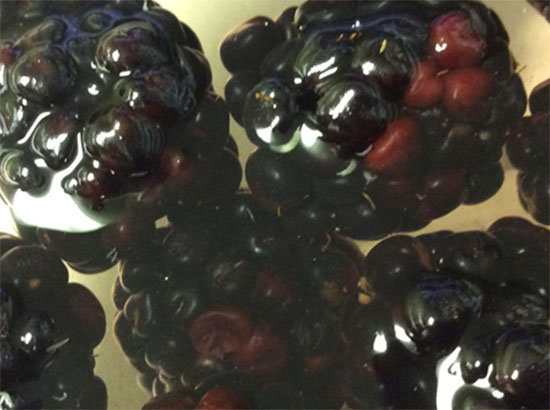
Spotted wing drosophila larva in blackberries. Especially visible on the berry in the upper right and the lower left as the small white larva. Photo: N. Johanning
Out in the vegetable field, most of our summer vegetables are in harvest. We have had our first harvest from field plasticulture bell peppers and tomatoes. So far I haven't heard of any major corn earworm flights in this area. I had a report from Southeastern llinois of no moths caught yet in the trap. I have been seeing a lot of stink bugs in peppers and tomatoes and some fruit damage so make sure to be scouting. Also, I have noticed bacterial leaf spot on peppers a lot of which I think got started earlier with some of the heavy rains back in a month or more ago. For these and other pest issues consult the 2017 Midwest Vegetable Production Guide for the best management options. Now is the time to be thinking about seeding transplants for fall brassica crops like cabbage, broccoli and cauliflower. In the pumpkin field, most growers have pumpkins in the ground and up. At home I have my pumpkins transplanted out. Despite being fairly dry, in no-till in wheat stubble there was a surprising amount of moisture and transplants are doing well.
Nathan Johanning (618-939-3434; njohann@illinois.edu)
Fruit and Vegetable Production and Pest Management
Modified Growing Degree Days (Base 50°F, January 1 through July 4) for Insect Development
Station Location |
Actual Total |
Historical Average (11 year) |
One- Week Projection |
Two-Week Projection |
|---|---|---|---|---|
Freeport |
1243 |
1119 |
1397 |
1558 |
St. Charles |
1217 |
1061 |
1365 |
1518 |
DeKalb |
1286 |
1186 |
1440 |
1596 |
Monmouth |
1558 |
1258 |
1717 |
1880 |
Peoria |
1730 |
1327 |
1901 |
2076 |
Champaign |
1586 |
1372 |
1761 |
1940 |
Springfield |
1927 |
1477 |
2114 |
2302 |
Perry |
1867 |
1379 |
2038 |
2213 |
Brownstown |
1978 |
1573 |
2167 |
2356 |
Belleville |
1992 |
1596 |
2181 |
2370 |
Rend Lake |
2115 |
1719 |
2309 |
2505 |
Carbondale |
1989 |
1628 |
2174 |
2362 |
Dixon Springs |
2136 |
1715 |
2324 |
2514 |
Insect development is temperature dependent. We can use degree days to help predict insect emergence and activity. Degree day accumulations calculated using the Illinois IPM Degree-Day Calculator (a project by the Department of Crop Sciences at the University of Illinois and the Illinois Water Survey).
Kelly Estes, State Survey Coordinator, Illinois Cooperative Agricultural Pest Survey (217-333-1005; kcook8@illinois.edu)
Insect Updates
Japanese Beetles
Japanese beetles are back. Reports statewide indicate Japanese beetles are here (and in some locations, in very high numbers.) With corn starting to tassel and getting close to tassel, it's important to remember, even though densities may appear to be extremely high, the average density of beetles across the field may be below levels of economic concern. An insecticidal treatment should be considered during silking if:
- There are 3 or more beetles per ear,
- Silks have been clipped to less than ½ inch, AND
- Pollination is less than 50% complete.
Also remember, that there are usually clumbers of Japanese beetles near field edges and if those are the only locations sampled, it will skew the numbers.
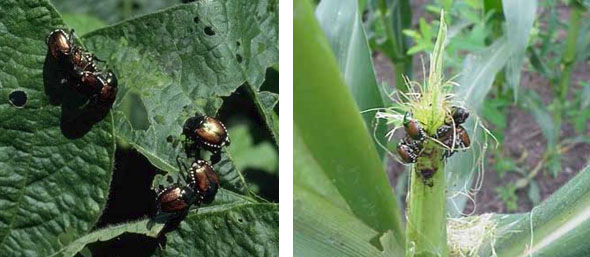
Corn Earworm
Corn earworm flights have been steady for 2 weeks with several locations peaking 6/15-6/20. Moths will lay eggs in the evening and with hatch in 3-4 days at 77F. Larvae feed on whorl stage corn and other host plants for a period of 3 to 4 weeks before burrowing into the soil to pupate. We expect a second generation of larvae and moths to peak in late summer.
Fall Armyworm
Flights of fall armyworm have also been low, but consistent. There is a good chance we may still see these numbers pick up. Fall armyworm will feed during the day and night unlike the night-feeding armyworm. Early symptoms may be similar to corn borer feeding (small holes and window-pane feeding in the leaves.) As larvae get larger, they will consume more leaf tissue before moving to the ear as plants begin to tassel.
Spotted Wing Drosophila
Spotted wing drosophila has become a serious pest for both specialty crop growers as well as home gardeners. This invasive fruit fly will insert eggs into healthy fruit, leading to the immature stages (maggots) that feed on the fruit flesh causing decay and reduction of quality. Often times, there is no outward indication of an infestation. While populations are low in the spring, they will gradually increase throughout the summer and later season fruit tend to have more damage. In our 2017 orchard survey, SWD has been confirmed in Pope, Champaign, and DeKalb counties in the last two weeks.

Brown Marmorated Stink Bug
We continue to monitor the spread of brown marmorated stink bug in Illinois. Populations continue to grow. Most issues stem around it being a nuisance pest in homes, though we expect to see injury in agricultural and specialty crops in the near future. Gardeners in urban areas with high populations should keep an eye on home gardens.

Kelly Estes, State Survey Coordinator, Illinois Cooperative Agricultural Pest Survey (217-333-1005; kcook8@illinois.edu)
Transplanting Cucurbits
There are some cases that we do transplant some of our cucurbit crops. It might be early in the season and we can get some plants a head start or in the case of pumpkins we if we have long season pumpkin plants we can give them a head start. Also if we need to get things growing and rain keeps us out of the field, we can buy some time with transplants. We often think more of transplants with tomatoes, peppers, or some brassicas, but most all of our cucurbits can do fairly well. 72 or 96 count plug trays are ideal for starting transplants. This time of year you can start transplants outside on concrete, gravel, pallets or whatever you have available, just try to have a surface that the plants will not root down into. For most cucurbits it takes 2-3 weeks to get a 1-3 leaf transplant. In my experience, the smaller the better, but they have to be big enough and have enough roots to hold the plug together to easily pull out of the tray. If they get much more that 2 fully expanded leaves they get hard to run through a transplanter, and also, there seems to be more transplant shock. Even with good soil moisture and a dose of water with the transplanter or watering can, plants will go through a period of transition as they get used to the field. It is normal for any fully expanded leaves at transplanting to wilt and sometimes die, but the crucial indicator is the health of the new leaves. Here is a picture of a pumpkin plant about 5 days after transplanting. You can see the two older leaves that were fully expanded at transplanting are somewhat yellow and wilted, but note the deep green color and health of that new leaf.
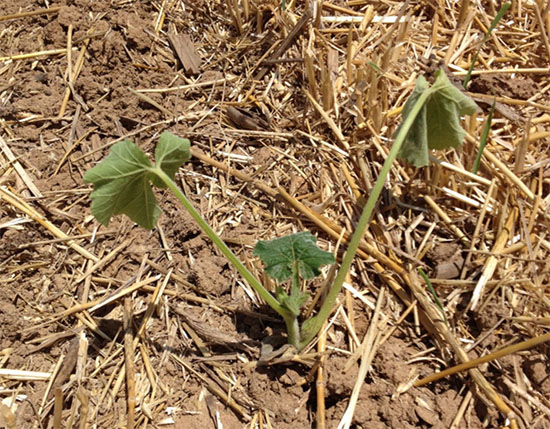
Pumpkin plant 5 days after transplanting. Photo: N. Johanning
This plant will not look back from this point forward as far as its growth. In the last more than decade, I have been no-till transplanting pumpkins in conditions from droughts to literally during hurricane rains, I have always seen greater than 95% success rate of plants after transplanting. I wouldn't say that in a few drought years I wasn't a little nervous, but it all worked out and the plants ended up doing just fine.
What can you gain from transplanting? Last year we transplanted and direct seed pumpkin plots side by side and the transplants were ahead in growth by about 10 days throughout the season including through harvest with earlier ripe fruit. Also, that head start can also give you an advantage on out competing weed control as well. While not for every scenario, situation, and grower this is another option to keep in mind to help in cucurbit production.
Nathan Johanning (618-939-3434; njohann@illinois.edu)
Hops Highlight: Variety Selection
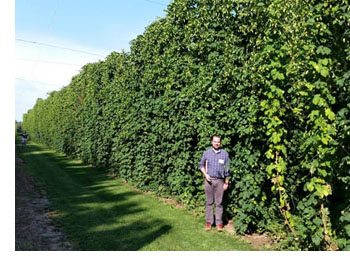 When considering hops production, you will need to decide on varieties. While fruit and vegetable varieties have different colors, shapes, texture, and other features, all varieties of hops look the same in growth and cone shape/color. You'll be choosing a variety based on other characteristics. This includes climate, variety demand, alpha acids, beta acids, disease resistance, and good storage ability.
When considering hops production, you will need to decide on varieties. While fruit and vegetable varieties have different colors, shapes, texture, and other features, all varieties of hops look the same in growth and cone shape/color. You'll be choosing a variety based on other characteristics. This includes climate, variety demand, alpha acids, beta acids, disease resistance, and good storage ability.
If you want to sell to home brewers and microbreweries, you want to pick a variety that they want based on their beer recipes. There are some varieties that even if they perform well, are disease resistant, and overall yield well, are not popular with brewers and you may have to create your own market to sell these. Reach out to your end user now to see what varieties they use and what you could grow for them.
The major criteria you should consider is alpha acids, beta acids, and good storage ability. With alpha acids, there are 3 alpha acids and several minors with the ratio dependent on the variety. A high alpha acid is one that is between 12-19%. Beta acids are those that are insoluble in water and give the bitter flavor to the beer. The good storage ability is the % of alpha acids after 6 months of cold (freezer) storage. A variety that has good storage ability may be important if you are drying and packaging hops to sell later.
Some hop varieties have downy and/or powdery mildew resistance. While these varieties perform and yield well, you may find that the variety is not one that your end user wants.
Keep in mind when growing hops that it will be three years for full establishment. This is especially important if you are growing a variety that is not common or a variety that seems to be popular right now but could wane in popularity by year 3.
Recommended varieties from Midwest trials include Centennial, Cascade, Nugget, Brewer's Gold, Newport, Horizon, Chinook, and many others. Each of these will have different acids and be appropriate for certain beer recipes. You'll find all of these from most companies that sell hop plants. Other Midwestern Universities have on-going variety trials and I recommend looking at those results compared to other regions of the United States.
Variety selection is crucial for a successful hop operation and it really comes down to who your end user is going to be as you make your selection.
Grant McCarty (815-235-4125; gmccarty@illinois.edu)
Less Seriously...
"A day without sunshine is like, you know, night."
-- Steve Martin
"Never put off till tomorrow what may be done day after tomorrow just as well."
-- Mark Twain
"I love deadlines. I love the whooshing noise they make as they go by."
-- Douglas Adams, The Salmon of Doubt
"Beauty is in the eye of the beholder and it may be necessary from time to time to give a stupid or misinformed beholder a black eye."
-- Jim Henson
"Whenever I feel the need to exercise, I lie down until it goes away."
-- Paul Terry
"Some people never go crazy. What truly horrible lives they must lead."
-- Charles Bukowski
"Reality continues to ruin my life."
-- Bill Watterson, The Complete Calvin and Hobbes
"The statistics on sanity are that one out of every four people is suffering from a mental illness. Look at your 3 best friends. If they're ok, then it's you."
-- Rita Mae Brown
"Fate is like a strange, unpopular restaurant filled with odd little waiters who bring you things you never asked for and don't always like."
-- Lemony Snicket
"When you're in jail, a good friend will be trying to bail you out. A best friend will be in the cell next to you saying, 'Damn, that was fun'."
-- Groucho Marx
"Never memorize something that you can look up."
-- Albert Einstein
University of Illinois Extension Specialists in Fruit and Vegetable Production & Pest Management
Extension Educators – Local Food Systems and Small Farms |
||
Bronwyn Aly, Gallatin, Hamilton, Hardin, Pope, Saline, and White counties |
618-382-2662 |
|
Katie Bell, Franklin, Jackson, Perry, Randolph, & Williamson counties |
618-687-1727 |
|
Sarah Farley, Lake & McHenry counties |
847-223-8627 |
|
Nick Frillman, Woodford, Livingston, & McLean counties |
309-663-8306 |
|
Laurie George, Bond, Clinton, Jefferson, Marion, & Washington counties |
618-548-1446 |
|
Zachary Grant, Cook County | 708-679-6889 | |
Doug Gucker, DeWitt, Macon, and Piatt counties |
217-877-6042 |
|
Erin Harper, Champaign, Ford, Iroquois, and Vermillion counties |
217-333-7672 |
|
Grace Margherio, Jackie Joyner-Kersee Center, St. Clair County |
217-244-3547 |
|
Grant McCarty, Jo Daviess, Stephenson, and Winnebago counties |
815-235-4125 |
|
Katie Parker, Adams, Brown, Hancock, Pike and Schuyler counties |
217-223-8380 |
|
Kathryn Pereira, Cook County |
773-233-2900 |
|
James Theuri, Grundy, Kankakee, and Will counties |
815-933-8337 |
|
Extension Educators – Horticulture |
||
Chris Enroth, Henderson, Knox, McDonough, and Warren counties |
309-837-3939 |
|
Richard Hentschel, DuPage, Kane, and Kendall counties |
630-584-6166 |
|
Andrew Holsinger, Christian, Jersey, Macoupin, & Montgomery counties |
217-532-3941 |
|
Extension Educators - Commercial Agriculture |
||
Elizabeth Wahle, Fruit & Vegetable Production |
618-344-4230 |
|
Nathan Johanning, Madison, Monroe & St. Clair counties |
618-939-3434 |
|
Campus-based Extension Specialists |
||
Kacie Athey, Entomology |
217-244-9916 |
|
Mohammad Babadoost, Plant Pathology |
217-333-1523 |
|